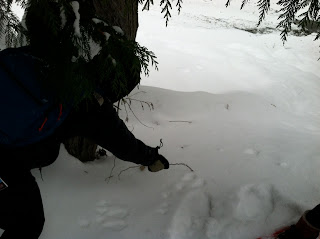The group learned the
difference in the front foot placement of ground dwelling hoppers, like the
snowshoe hare, and tree dwelling hoppers, such as the red squirrel. Tree dwelling
hoppers’ front feet land parallel to one another, while ground hoppers’ are
usually staggered.
 |
| Snowshoe hare track showing uneven front feet placement |
 |
| Red squirrel tracks with parallel front and back feet placement. |
We encountered the tracks of a walking animal, most likely a deer. Annika took the chance to explain how the most efficient way of moving in the snow for walking animals (felines, canines, and undulates) is to place their back foot in the track left from their front foot, leaving a track that looks as if it was created by animal with only two legs.
 |
| Examining the tracks |
 |
| Two of the people on the tour demonstrate how a four legged animal could walk more efficiently in the snow by stepping into the tracks left by the front feet |
We saw the zipper-like track of a mouse- a hopper that leaves a tail track.
Some lucky squirrel
has found a prime dining spot. Here we can see the remnants of its pine cone
feast!
In the end, we all left feeling more appreciative of nature!



No comments:
Post a Comment